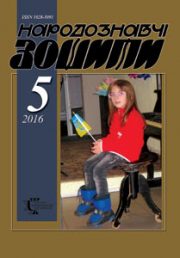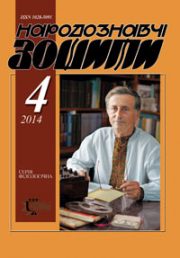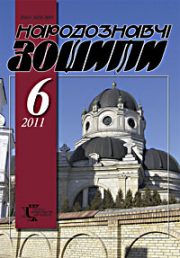The Ethnology Notebooks. 2023. № 6 (174), 1386—1396
UDK 069.51:64]:069:908]](477.53-22Диканька)(045)
DOI https://doi.org/10.15407/nz2023.06.1386
CEILINGS BEAM (SVOLOK) 1741 FROM THE DYKANKA HISTORICAL AND LOCAL STORY MUSEUM
SHCHERBAN Anatolii
- ORCID ID: https://orcid.org/0000-0002-9530-6453
- Doctor of Culturolodgy, Candidate of Historical Sciences,
- Associate Professor, head of the department of museum and tourist activity,
- 4, Kharkiv State Academy of Culture, Bursatskyi uzviz, 61057, Kharkiv,Uknaine,
- Contacts: e-mail: kosaks_1978@ukr.net
BABKOVA Nadiia
- ORCID ID: https://orcid.org/0000-0003-0347-0633
- Candidate of Historical Sciences,
- head of the educational laboratory for museology and heritage studies,
- 4, Kharkiv State Academy of Culture, Bursatskyi uzviz, 61057, Kharkiv, Ukraine,
- Contacts: e-mail:academikxdak@gmail.com
Abstract. The small number of ceilings beams (svoloks) from the early modern period of the history of Ukraine are kept in national museum collections. Most of them have been put into scientific circulation, except for the product of 1741, discovered in 1982 in the village of Klymkivka (Dykanka district), which is now exhibited in the Dykanka Historical and Local Story Museum.
The purpose of this article is to characterize this ceiling beam (svolok), which is still little known to scientists. To achieve it, a complex of methods and approaches characteristic of museological, historical and art history disciplines were involved. In particular, the principle of historicism, methods of comparative and visual analysis, formal-stylistic and hermeneutic.
It turned out that the analyzed ceiling beam (svolok) is a rare museum exhibit. The founder of the dwelling, from which it comes, was the representative of the Cossack officers of the Hetmanate, Shishaky sotnyk Fedir Yakovenko. After carrying out a comparative analysis with similar ceiling beams (svoloks) from other museum institutions, a set of common and distinctive features of its decor with the ceiling beams (svoloks) of Cossack officers of the 18th century was revealed Transnistria and the Catholic world of Central-Eastern Europe. The inscriptions on the front side bring it closer to the almost synchronous ceiling beams (svoloks) of the Zaporozhians, the title of the owner — with the ceiling beams (svoloks) of the Kishenka sotnyk and another Cossack foreman.
The image of the symbols of the Passion of Jesus Christ on both sides of the cross is one of the earliest ceiling beams (svoloks) of this type — Sazont Grabovskyi from the funds of the National Historical and Ethnographic Reserve «Pereyaslav». The inscription and most of the images on the back are original. The rosettes carved from the bottom bring together the «dykanka» ceiling beam (svolok) with similar products from Western Ukraine, Pokuttia, and the Lesser Poland and Mazowiecki Voivodeships of the Republic of Poland.
The author’s version regarding the semantics of the images and inscriptions on this and other ceiling beams (svoloks) of the early modern period of the Naddniprianshchyna region is expressed.
Keywords: early modern period, ceiling beam (svolok), museum object, museum, symbology, cossack officers.
Received 7.11.2023
REFERENCES
- Kulish, P.A. (1843). Mikhailo Charnyshenko or Little Russia eighty years ago: essay by P. Kulish (Part 1). Kiev: Universitetskaya tip [in Russian].
- Skalkovskii, A. (1846). The History of the New Sich or the last Zaporozhian Host: compiled from original documents of the Zaporozhian Sich Archive (Part 3). Odessa: [Pech. v Gor. tip.] [in Russian].
- Vertilyak, D.Ch. (1850). The Zaporizhian antiquity: Inscriptions on grave crosses and crypts. The Inscriptions on the house scum. Zapiski Odesskogo obshhestva istorii i drevnostej, (2), 823—825 [in Russian].
- Jevarnickij, D.I. (1888). Zaporozhye in the remnants of antiquity and folk tales (Vol. 2). Sankt-Peterburg: Izdanie L.F. Panteleeva [in Russian].
- N., B. (1904). The old ceiling beam. Arheologicheskaya letopis Yuzhnoj Rossii (3), 95—96 [in Russian].
- Sumcov, N.F. (1890). The vestiges of cultural. Kiev: Tipografiya G.T. Korchak-Novickogo [in Russian].
- Yavornyts’kyj, D.I. (1990). The history of Zaporozhian Cossaks (Vol. 1). Kyiv: Naukova dumka [in Ukrainian].
- (2008). The list of the museum objects from the funds of the NSLSM. The Mykytyn Zaporizhian Sich and the beginning of the National Liberation War of the Ukrainian people in the middle of the 17th century: proceedings of the All-Ukrainian Scientific Conference (Pp. 97—103). Nikopol’: RPTs Sich [in Ukrainian].
- Vasylenko, A.Yu. (2010). The ornament on the ceiling beams of the Cossack age: interpretation and analysis of elements. Khortytsya Nature Reserve. The history of the Zaporizhzhya Cossacks: in monuments and museum practice: proceedings of the IV international Scientific and Practical Conference (Pp. 210—214). Zaporizhzhia: A&V. Art CROUP [in Ukrainian].
- Yatsenko, S.P. (2010). The beam from the Zaporizhzhia oblast Local Lore Museum collection. Muzejnyj visnyk, 10, 9—15 [in Ukrainian].
- Zham, O., & Hrudevych, T. (2021). The svolok from chinbar`s house at the museum of folk architecture and life of the middle Dnieper: historical, graphical and artistical review. Siverian chronicle, 6, 25—35. Retrieved from: https://doi.org/10.5281/zenodo.5804536 [in Ukrainian].
- Pryharin, O. A. (1995). The inscriptions on the ceiling beams of the houses of Zaporizhian Cossacks. Regional and general in history: Abstracts of Papers of the International Scientific Conference (Pp. 137—140). Dnipropetrovs’k: Porohy [in Ukrainian].
- (1914). The A.N. Pol’ Katerynoslav museum. Ukraine, I, 150—151 [in Ukrainian].
- (1885). The Razumovskii oldest house in Lemeshi. Moskvityanin, 6, 187—188 [in Russian].
- (1926). The brief overview of the work of the Kharkiv Museum of Ukrainian Art for 1925. CHervonij shlyah, 5, 247 [in Ukrainian].
- Taranushenko, S.Yu. (2011). The Housing of the old Slobozhanshchyna. Kharkiv: Kharkivs’kyj pryvatnyj muzej mis’koi sadyby [in Ukrainian].
- Miloradovich, V.P. (1902). The life and existence of a Lubny peasants. Kievskaya starina, 77, 110—135 [in Russian].
- Lotots’ka, V. (2016). The sacredness of floral motifs in the Ukrainian plastic art. The ethnology notebooks, 6, 1423—1427 [in Ukrainian].
- Moklowski, K. (1903). The folk art in Poland. Lwow; Krakow: nakl. Ksiegarni H. Altenberga; druk W.L. Anczyca i Spolki [in Polish].
- Puset, L. (1903). Study on Polish wooden construction. I. Cottage. Krakow: nakladem Akademii umiejetnosci [in Polish].
- Kryvosheia, V.V., Kryvosheia, I.I., & Kryvosheia, O.V. (2009). Non-governmental foreman of the Hetmanate. Kyiv: Stylos [in Ukrainian].
- (2022). The local history trails of Buziv region. Kyiv: Huliaieva V.M. [in Ukrainian].
- (1989). The descriptions of the Kyiv Viceroyalty of the 70s and 80s of the 18th century: Descriptive and statistical sources. Kyiv: Naukova dumka [in Ukrainian].







